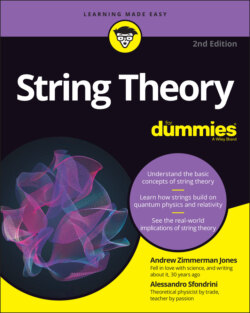Читать книгу String Theory For Dummies - Andrew Zimmerman Jones - Страница 57
Being the most popular theory in town
ОглавлениеMany young physicists feel that string theory, as the primary theory of quantum gravity, is the best (or only) avenue for making a significant contribution to our understanding of this topic. Over the last three decades, high-energy theoretical physics (especially in the United States) has become dominated by string theorists. In the high-stakes world of “publish-or-perish” academia, this is a major success.
Why do so many physicists turn toward this field when it offers no experimental evidence? Some of the brightest theoretical physicists of either the 20th or the 21st centuries — Edward Witten, John Henry Schwarz, Leonard Susskind, and others you meet throughout this book — continually return to the same common reasons in support of their interest:
If string theory were wrong, it wouldn’t provide the rich structure that it does, such as with the development of the heterotic string (see Chapter 10), which allows for an approximation of the Standard Model of particle physics within string theory.
If string theory were wrong, it wouldn’t lead to better understanding of quantum field theory, quantum chromodynamics (see Chapter 8), or the quantum states of black holes, as presented by the work of Leonard Susskind, Andrew Strominger, Cumrun Vafa, and Juan Maldacena (see Chapters 11, 13, and 16).
If string theory were wrong, it would have collapsed in on itself well before now, instead of passing many mathematical consistency checks (such as those discussed in Chapter 10) and providing more and more elaborate ways to be interpreted, such as the dualities and symmetries that allowed for the presentation of M-theory (discussed in Chapter 11).
This is how theoretical physicists think, and it’s why so many of them continue to believe that string theory is the place to be. The mathematical beauty of the theory, the fact that it’s so adaptable, is seen as one of its virtues. The theory continues to be refined, and it hasn’t been shown to be incompatible with our universe. There has been no brick wall where the theory failed to provide something new and — in some eyes, at least — meaningful, so those studying string theory have had no reason to give up and look somewhere else. (The history of string theory in Chapters 10 and 11 offers a better appreciation of these achievements.)
Whether this resilience of string theory will translate someday into proof that the theory is fundamentally correct remains to be seen, but for the majority of those working on the problems, confidence is high.
As you can read in Chapter 18, this popularity is also seen by some critics as a flaw. Physics thrives on the rigorous debate of conflicting ideas, and some physicists are concerned that the driving support of string theory, to the exclusion of all other ideas, isn’t healthy for the field. For some of these critics, the mathematics of string theory has indeed already shown that the theory isn’t performing as expected (or, in their view, as needed to be a fundamental theory) and string theorists are in denial.
